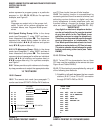
REMOTE ADMINISTRATION AND MAINTENANCE PROCEDURES
SECTION 100-816-600
MARCH 1993
-11-
8.10 System Record Sheets
8.11 Before system data can be programmed, the
System Record Sheets which contain the customer
data base must be available (see Programming,
Section 200-816-302).
8.20 Program Types
8.21 There are three types of programs:
Type 1: All Type 1 programs use the same proce-
dure; however, each button/LED has a different
meaning, depending on the program number.
The status of this data is reviewed, changed,
and stored in system memory using Type 1
program procedures.
Type 2: All Type 2 programs follow the same entry
procedure; however, they require port number
and button/LED entries. Each button/LED has a
different meaning, depending on the program
number.
Type 3: In this type program, the information shown
in the System Record Sheet indicates the data to
be stored in system memory. Each program has
a different meaning, and the data is reviewed,
changed or stored in memory using an individual
procedure for each program.
8.30 Multiple Station (Range) Programming
8.31 Some programs select options for individual
stations (where ■ ■■ ■ represents the port number
being programmed). To save time, it is possible to
program all ports or a range of ports simultane-
ously.
8.32 Multiple station programming is accomplished
by substituting a range of ports (■ ■■ ■ * ■ ■■ ■) for the
port number part (■ ■■ ■) of the program.
Example, all ports: 0 0
* 0 9 (DK8) or 0 0 * 1
9
(DK16)
8.33 When the multiple station range is entered,
the terminal displays existing data as follows:
Y or N: Y or N indicates if a button LED is ON or
OFF; if DATA is the same for all ports in the
dialed group: Y = button/LED "ON"; N = button/
LED "OFF."
U: If DATA is not the same for all ports, U indicates
that the button/LED is "ON" for at least one, but
not all ports, in that group.
8.40 Programming Procedures
1) Refer to a completed System Record Sheet.
2) Place the terminal into the program mode per
Paragraph 7.
3) Program procedures are categorized and pre-
sented in the following order. Use these pro-
cedures to store System Record Sheet data in
working memory.
a) Initialization procedures:
These procedures must be completed
whenever a system is first installed (see
Type 3 programs).
b) Type 1 programs:
10-1, 10-2, 10-3, 15, 16, 42-0, 77-1, 77-
2.
c) Type 2 programs:
Station Class of Service;
20, 30, 31, 35, 40, 41, 43, 79, 81 ~ 89.
d) Type 3 programs:
Initialization; 90, 92
General; 00, 01, 02 03, 04, 05, 12, 13,
21, 22, 19, 28, 29, 32, 33, 34, 36, 37,
38, 39, 42-1 ~ 8, 44, 60, 69, 70, 78,
80, 93.
Toll Restriction; 45 ~ 48.
Least Cost Routing; 50 ~ 56.
9 DATA DUMP MODE
9.00 General
9.01 This mode allows three types of data to be
displayed or output to a printer: Programs (Cus-
tomer Data Base), Speed Dialing Numbers (Sta-
tion/System), and LCD Messages (Station/Sys-
tem).
9.02 The three procedures for the Data Dump
mode are called: Program Dump, Speed Dialing
Dump, and LCD Messages Dump.
9.03 Program Dump: While in the dump mode
(see Paragraph 7), enter "PRG" and up to three
characters and press CR. The alphanumeric char-


















